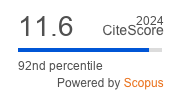AUTOMATED MODULATION CLASSIFICATION SYSTEM FOR SOFTWARE DEFINED RADIO
DOI:
https://doi.org/10.29284/ijasis.4.2.2018.1-7Keywords:
Automated modulation classification, machine learning algorithms, dimensionality reduction techniques, software defined radioAbstract
An Automatic Modulation Classification (AMC) system for Software Defined Radio (SDR) is presented in this study. Initially, the generated signals are modulated using different modulation techniques. Then, noise is added to the generated signals by using Additive White Gaussian Noise (AWGN). The noise added signal is used for further process to extract features and classification. The system uses Discrete Wavelet Transform (DWT) to analyze the signal that produces lower and higher frequency sub-bands. The Independent Component Analysis (ICA) is employed on lower frequency sub-band for dimensionality reduction. Finally, the classification is made by Pulse Coupled Neural Network (PCNN). The system uses three different digital modulation schemes; Phase Shift Keying (PSK), Quadrature Amplitude Modulation (QAM), and Differential PSK (DPSK). The results show the DWT, ICA and PCNN based AMC system provides promising results under various noise densities.
References
F. Benedetto, A. Tedeschi, and G. Giunta, “Automatic blind modulation recognition of analog and digital signals in cognitive radios”, Vehicular Technology Conference, 2016, pp. 1-5.
M. Zamanian, A.A. Tadaion, and M.T. Sadeghi, “Modulation classification of linearly modulated signals in a cognitive radio network using constellation shape”, International Workshop on Systems, Signal Processing and their Applications, 2011, pp. 13-16.
B. Ramkumar, T. Bose, and M.S. Radenkovic, “Combined blind equalization and automatic modulation classification for cognitive radios”, Digital Signal Processing Workshop and IEEE Signal Processing Education Workshop, 2009, pp. 172-177.
R. Kannan, and S. Ravi, “Digital signals classification in cognitive radio based on discrete wavelet transform”, International Conference on Control Engineering and Communication Technology, 2012, pp. 870-873.
W. Guibene, and D. Slock, “Signal classification in heterogeneous OFDM-based cognitive radio systems”. ICT, 2013, pp. 1-5.
X. Zhu, and T. Fujii, “Modulation classification in cognitive radios for satellite and terrestrial systems”, International Conference on Communication Workshop, 2015, pp. 1612-1616.
J.J. Popoola, and R. van Olst, “Application of neural network for sensing primary radio signals in a cognitive radio environment”, IEEE Africon'11, 2011, pp. 1-6.
E. Rebeiz, F.L. Yuan, P. Urriza, D. Marković, and D. Cabric, “Energy-efficient processor for blind signal classification in cognitive radio networks”, IEEE Transactions on Circuits and Systems I: Regular Papers, Vol. 61, No. 2, 2013, pp. 587-599.
Z. Ye, G. Memik, and J. Grosspietsch, “Digital modulation classification using temporal waveform features for cognitive radios”, International Symposium on Personal, Indoor and Mobile Radio Communications, 2007, pp. 1-5.
M. Petrova, P. Mähönen, and A. Osuna, “Multi-class classification of analog and digital signals in cognitive radios using support vector machines” International Symposium on Wireless Communication Systems, 2010, pp. 986-990.
G. Sowmya, K. Meghana, B. Subbarayudu, R.C.A. Naidu, and G. Keerthi, “The video hiding technique based on DWT and genetic algorithm with boolean functions”, International Conference on Next Generation Computing Technologies, 2016, pp. 843-849.
R. Choudhary, and G. Parmar, “A robust image watermarking technique using 2-level discrete wavelet transform (DWT)”, International Conference on Communication Control and Intelligent Systems, 2016, pp. 120-124.
X. Zhang, and X. Ren, “Two dimensional principal component analysis based independent component analysis for face recognition”, International Conference on Multimedia Technology, 2011, pp. 934-936.
V. Singh, S.K. Yadav, N.K. Singh, and P.K. Kalra, “Color image compression using block-based independent component analysis” International Symposium on Image and Signal Processing and Analysis, 2007, pp. 288-292.
L. Xiaofang, C. Dansong, T. Xianglong, and L. Jiafeng, “Multi-object segmentation based on pulse coupled neural network”, Cybernetics and Intelligent Systems, 2008, pp. 744-748.
N. Chen, Z.B. Qian, S.X. Zhao, and J.S. Fan, “Region Growing Based on Pulse-Coupled Neural Network”, International Conference on Machine Learning and Cybernetics, Vol. 5, 2007, pp. 2832-2836.
Downloads
Published
Issue
Section
License
This work is licensed under a Creative Commons Attribution 4.0 International License, which permits unrestricted use, distribution, and reproduction in any medium, provided the original work is properly cited.











